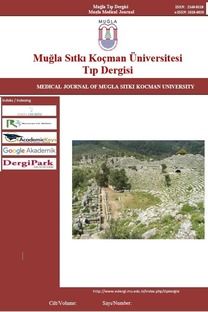Muğla Bölgesinde Sakral Dismorfizim Bulgularının Sıklığı
Anormal Sakrum, Pelvik Cerrahi, Pelvik Travma, Sakral Dismorfizm
Frequency of Sacral Dysmorphism Findigs in Mugla Region
Abnormal Sacrum, Pelvic Surgery, Pelvic Trauma, Sacral Dysmorphism,
___
- 1. Matson DM, Maccormick LM, Sembrano JN et.al. Sacral Dysmorphism and Lumbosacral Transitional Vertebrae (LSTV) Review. Int J Spine Surg. 2020;14(1):14-9.
- 2. Kılınç, C. Y. Posterior Pelvik Halka Yaralanmalarında Hangi Teknik Seçilmelidir: Perkütan Sakroiliak Vida Fiksasyonu Ya Da Posterior Perkutan Transiliak Plak Fiksasyonu? Kırıkkale Üni Tıp Fak Derg. 2019;21(1):80-4.
- 3. Enninghorst N, Toth L, King KL et.al. Acute definitive internal fixation of pelvic ring fractures in polytrauma patients: a feasible option. J Trauma. 2010;68(4):935-41.
- 4. Gardner MJ, Farrell ED, Nork SE, et al. Percutaneous placement of iliosacral screws without electrodiagnostic monitoring. J Trauma. 2009;66(5):1411-5.
- 5. Cole JD, Blum DA, Ansel LJ. Outcome after fixation of unstable posterior pelvic ring injuries. Clin Orthop Relat Res. 1996;(329):160-79.
- 6. Moed BR, Geer BL. S2 iliosacral screw fixation for disruptions of the posterior pelvic ring: a report of 49 cases. J Orthop Trauma. 2006;20(6):378-83.
- 7. Routt ML Jr, Kregor PJ, Simonian PT et.al. Early results of percutaneous iliosacral screws placed with the patient in the supine position. J Orthop Trauma.1995;9(3):207-14.
- 8. Schweitzer D, Zylberberg A, C´ordova M et.al. Closed reduction and iliosacral percutaneous fixation of unstable pelvic ring fractures. Injury. 2008;39(8):869-74.
- 9. Alemdaroğlu, K. B., Yücens, M., Kara, T. et.al. Pedicle axis view c ombined by sacral mapping can decrease fluoroscopic shot count in percutaneous iliosacral screw placement. Injury. 2014; 45(12):1921-7.
- 10. Tile MH, Kellam JF: Fractures of the Pelvis and Acetabulum, ed 3. Philadelphia, PA, Lippincott Williams & Wilkins, 1995; pp199-208.
- 11. Sagi HC, Lindvall EM.Inadvertent intraforaminal iliosacral screw placement despite apparent appropriate positioning on intraoperative fluoroscopy. J Orthop Trauma. 2005;19(2):130-3.
- 12. 12.Altman DT, Jones CB, Routt ML Jr. Superior gluteal artery injury during iliosacral screw placement. J Orthop Trauma. 1999;13(3):220-7.
- 13. Ko PS, Kou SK. A rare complication of percutaneous iliosacral screw in a vertically unstable pelvic disruption in a child. Injury. 2001;32(2):159-61.
- 14. Peeters G, Govaers K, Himpens J. Successful laparoscopic exploration and screw extraction for intractable pain after anterior iliosacral arthrodesis. J Orthop Trauma. 2010;24(10):83-5.
- 15. Weil YA, Nousiainen MT, Helfet DL. Removal of an iliosacral screw entrapping the L5 nerve root after failed posterior pelvic ring fixation: a case report. J Orthop Trauma. 2007;21(6):414-7.
- 16. Templeman D, Schmidt A, Freese J et.al. Proximity of iliosacral screws to neurovascular structures after internal fixation. Clin Orthop Relat Res. 1996;(329):194-8.
- 17. Routt MLC, Simonian PT, Agnew SG, et al. Radiographic recognition of the sacral alar slope for optimal placement of iliosacral screws: a cadaveric and clinical study. J Orthop Trauma. 1996;(10):171–7.
- 18. Conflitti JM, Graves, ML, Routt Jr, MC. Radiographic quantification and analysis of dysmorphic upper sacral osseous anatomy and associated iliosacral screw insertions. J Orthop Trauma. 2010;24(10):630-6.
- 19. Kaiser SP, Gardner MJ, Liu J, et.al. Anatomic determinants of sacral dysmorphism and implications for safe iliosacral screw placement. JBJS. 2014; 96(14):e120.
- 20. Chung HJ, Park J, Sohn HS, et.al. The usefulness of reformatting CT scanning plane to distinguish sacral dysmorphism and introducing the variable of elevated height for predicting the possibility of trans-sacral screw fixation. Orthop Traumatol Surg Res. 2020;106(1):109-15.
- 21. Radley JM, Hill BW, Nicolaou DA, et.al. Bone density of first and second segments of normal and dysmorphic sacra. J Orthop Traumatol. 2020;21(1):1-6.
- 22. Ozmeric A, Yucens M, Gultaç E, et.al. Are two different projections of the inlet view necessary for the percutaneous placement of iliosacral screws? Bone Joint J. 2015;97:705-10.
- 23. Hinsche AF, Giannoudis PV, Smith RM. Fluoroscopy-based multiplanar image guidance for insertion of sacroiliac screws. Clin Orthop Relat Res. 2002;395:135-44.
- ISSN: 2148-8118
- Yayın Aralığı: Yılda 3 Sayı
- Başlangıç: 2014
- Yayıncı: Muğla Sıtkı Koçman Üniversitesi
Vajinitlerde Etiyoloji Değişiyor mu? Tek Merkez Verilerinin Paylaşımı
Göksu ALAÇAMLI, Sema TAMER KADERLİ, Aylin KARALEZLİ, Nilay HAKAN
Acil Servisimize Başvuran Hastaların 5 Yıllık Analizi
Ekrem Taha SERT, Hüseyin MUTLU, Kerim YEŞİLDAĞ, Kamil KOKULU, AYHAN SARITAS
Venöz Numune Almada Preanalitik Hataların Tespiti; Acil Servis Deneyimi
Erdem ÇOKLUK, Mehmet Ramazan ŞEKEROĞLU, Fatıma Betül TUNCER, Fatih GÜNEYSU, Selvihan ÇİLLİOĞLU, Meltem BOZ
İleri Evre Mide Kanserli Türk Hastalarda XPD/ERCC2, RAD51 ve hOGG1 Gen Polimorfizmi
ÖZGÜR TANRIVERDİ, Gamze GÖKÖZ DOĞU, Ayşegül KARGI, HAKAN AKÇA, AYDIN DEMİRAY, Burcu YAPAR TASKÖYLÜ, Atike Gökçen DEMİRAY, Arzu YAREN, CAN ÖZLÜ, AHMET ERGİN
Paraaortik Lenf Nodu Diseksiyonu Sırasında Unilateral Ektopik Böbrek
Adem YAVUZ, Cevat Rıfat CÜNDÜBEY, Mehmet DOLANBAY
